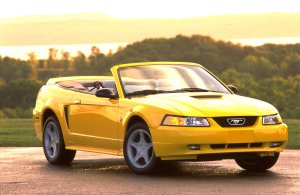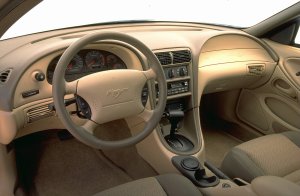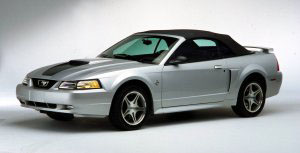By Greg Wilson

|
Knife-edge styling and more horsepower for ’99 Mustang
The 1999 Mustang’s sharper contours can be credited to Ford’s ‘New Edge’ styling theme now being used on some of Ford’s newer cars, such as the Mercury Cougar and the soon-to-be-introduced Ford Focus. Though its basic proportions are still the same as the 1993 model (when it was last redesigned), the ’99 Mustang now has definitive creases in the bodywork particularly leading into the non-functional side scoops and hood scoop. The perimeter around the headlamps and taillights has been squared-off, and the grille opening is also more square.
In addition, the ’99 Mustang has more pronounced wheel arches, restyled alloy wheels in 15, 16 and 17 inch diameter sizes, larger, 3-inch-diameter dual tail pipes on GT models, and 35th-anniversary tri-color emblems on the sides of the front fenders (the first Mustang was introduced in April of 1964.)
But while the Mustang’s sharper styling is getting most of the attention, it’s the mechanical upgrades that are most significant. Horsepower on both V6 and V8 engines has been increased significantly, handling has been improved, and traction control is a new, and worthwhile option.
The Mustang’s standard 3.8 litre V6 engine gets 40 more horsepower and 10 foot pounds of torque, and is now rated at 190 hp at 5,250 rpm and 225 lbs-ft at 3,000 rpm. The power increase was accomplished by improving engine breathing and efficiency: there’s a new intake manifold, cylinder head improvements and new piston coatings for reduced friction. In addition, a balance shaft was added to reduce engine noise and vibration.

When I first picked up my test car, a V6 convertible, I thought it had a V8 engine – the increased horsepower and torque is that impressive. The V6 engine has a throaty, macho burbling sound, much like a V8, and there’s lots of low-end torque which translates into responsive acceleration, and fewer gear changes. Under hard acceleration, the V6 is unashamedly unrefined, but at cruising speeds, the engine loafs along quietly at just 1800 rpm – which explains in part why this car gets such good highway gas mileage: 7.5 litres per 100 kilometres (38 mpg).
The 1999 Mustang GT’s revised 4.6 litre SOHC V8 has 35 more horsepower and 10 more foot pounds of torque. Horsepower is now 260 at 5,250 rpm and torque is now a significant 300 lbs-ft at 4,000 rpm. This was achieved with new higher-lift, longer-duration camshafts, bigger valves, and revised intake manifold runners that increase intake airflow above 2,000 rpm. The V8 engine also has coil-on-plug ignition for increased reliability and higher-energy sparking for more efficient combustion.
As before, a five-speed manual transmission is standard, and a four-speed automatic is optional. Both have a performance-oriented 3.27:1 rear axle ratio. The 5-speed manual shifter in my test car had medium-length throws with a solid, direct, mechanical feel that complemented the car’s visceral nature.
For the first time, Mustangs offer all-speed traction control, a system which reduces wheel spin, particularly on wet or slippery roads. The system uses the ABS sensors to detect excess drive-wheel spin, and reduces it by retarding ignition timing, reducing fuel flow, and appropriate brake application. A console-mounted on/off switch allows the driver the choice of turning it on or off.
Other changes for 1999 include improved steering center feel, and a reduced turning circle. To improve handling and ride, the rear track was increased by 1.4 inches and the jounce travel was increased by 1.5 inches. In addition, convertible models have additional underbody rail extenders to reduce body shake.

The Mustang’s interior remains much the same as before: its two distinctive half-round dashboard cowls wrap neatly down into the centre console area. In the centre dash area are large rotary knobs for the fan and temperature controls, however there’s no air recirculation switch. Below that is a well-marked white-on-black radio with a push-button volume control, and on the lower console is a 12 volt power outlet for accessories, and two cupholders, one of which can be converted to an ashtray. Mustang’s have a good set of gauges including tachometer, voltmeter, coolant temperature, and oil level gauges.
To accommodate taller drivers, the driver’s seat now has a one-inch-longer track, and an optional power driver’s seat also is now available with 6-way (instead of 4-way) power adjustment. Interior storage space is limited to a small central storage bin, a small glovebox, and map pockets on the doors.
A new combined AM/FM stereo/radio CD unit with upgraded speakers is now available as well as the high performance MACH 460 audio system with two amplifiers and powerful subwoofer assembly.
Convertible Mustangs, available in base, GT, and SVT Cobra models, have a power-operated top. The driver releases two latches in the header, presses a button on the console, and the top lowers in about 15 seconds. A flexible, vinyl tonneau cover (which stores in the trunk) slips over the lowered top to protect it and give the car a cleaner look. The convertible top features a glass rear window with defroster and padded interior liner.
With the top up, rear quarter visibility is restricted when changing lanes, but this is the case with most convertibles. With the top down, wind buffeting on the highway is acceptable and it’s possible to carry on a friendly conversation with your passenger.
Like most convertibles, the Mustang has a small trunk because the space needed to store the lowered top is taken from the trunk. With 2180 litres (7.7 cubic feet) of cargo area, the trunk in the Mustang convertible is about 2/3 the size of the Mustang Coupe’s trunk.
To deter car thieves, all Mustangs now come with a standard Securilok anti-theft system that uses an encoded ignition key. Any attempt to start the engine without the proper key electronically disables the engine. Ford reports that in the United States, the theft-rate for Mustangs has dropped 77 percent since Securilok became available.

Mustang enthusiasts may want to consider the 35th Anniversary option package, available on Mustang GT Coupes and convertibles. It includes body-colored hood scoop, rear spoiler, side scoops and rocker panels, a blacked-out panel between the taillamps, and 17 by 8 inch five-spoke aluminum wheels. Interiors include black leather and vinyl seats with silver inserts and pony logo, aluminum shift knob, a unique instrument cluster with 35th anniversary script, silver and black floor mats with 35th anniversary logo, and silver door trim inserts. 35th Anniversary Mustangs are available only in Black, Silver Metallic, White, and Red.
Mustang Coupes start at $20,995, Convertibles at $24,995, GT Coupes at $27,995, and GT Convertibles at $31,995. The high-performance SVT Cobra Coupe is $36,095 and the SVT Cobra Convertible is $39,495.
Technical Data:
|
||||||||||||||||||||||||||||||||||||










